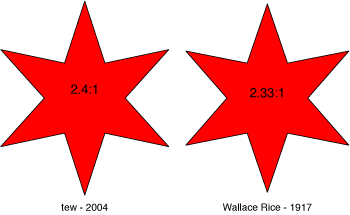continuing obsessive coverage of chicago stars
The journal of the Great Waters Association of Vexillology (the study of flags is called Vexillology) reports on the original proceedings of the 1917 Chicago City Council that adopted the flag design, which at that time, only had two stars. Here’s an image of the original flag as pictured in the Chicago Herald and Examiner in 1921, courtesy of the Chicago Historical Society. I’ll quote the relevant portion of Wallace Rice’s description here:
Next (to) the hoist and two inches from it at the nearest point is a red star fourteen inches tall with six points drawn from a circle six inches in diameter. Two inches from this is a second star of the same size. […] The two stars stand for the two great formative events in Chicago history, the Great Fire of 1871 and the World’s Columbian Exposition of 1893. They are given six points each that they may not be confused with the five-pointed stars which stand for the States of the Union in the American Flag.
The bold passage (emphasis mine, obviously) gives us numbers, slightly different from the numbers I calculated in my previous post, “what is the deal with the stars on the chicago flag?”. There, I got:
The outer radius (the circumradius) is 2.4 times the length of the inner radius (which, in Adobe parlance, is the circle which intersects the points of concavity, not the incircle of the hexagon).
The 1917 numbers give an outer radius 2.33 times the inner radius. Let’s compare these stars:
These stars are very, very similar, but more importantly, they’re both pointy. I was going to post a very long entry with all the trigonmetry necessary to show the exact percentage difference in area, but I think I’ll spare you, this time. The key here is that the star was designed to be sharp from the very start, and distinct from the regular hexagram.
Which of the two is most correct? It’s hard to say. I’m pretty sure that Rice’s 1917 14:6 number is just rounding error. He probably just didn’t want to write 14.4 inches. Since the difference is so very small, let’s call them both within the margin of error.
However, the stars on the very same page in the GWAV’s journal are wrong wrong wrong. Those are clearly regular hexagrams in the illustration, 1.73:1 six-pointed stars. I’m going to have to send them a letter.

Be careful, tew. They might respond with an honorary membership.